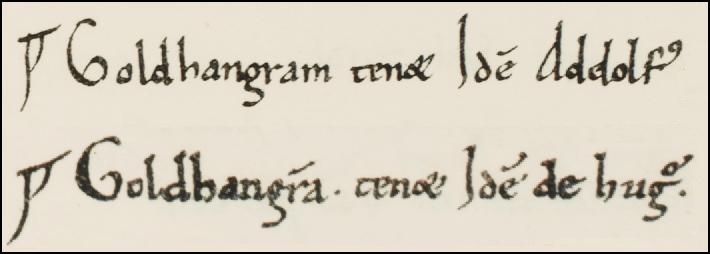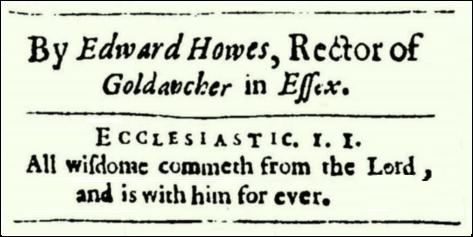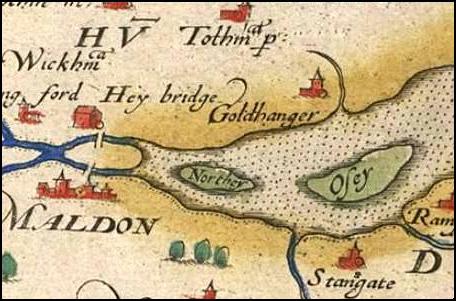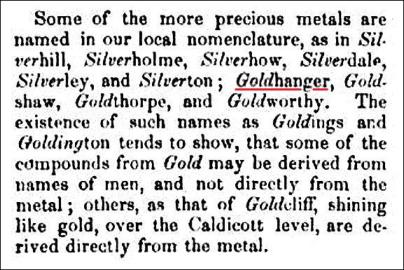|
The Name of the Village |
|||||||||||||||||||
|
|
contents |
|
|||||||||||||||||
|
|
|
||||||||||||||||||
|
|
|
||||||||||||||||||
|
|
|
||||||||||||||||||
|
|
|
||||||||||||||||||
|
|
|
||||||||||||||||||
|
|
|
||||||||||||||||||
|
also included towards
the end of this webpage are... Street & Road Names House & Farm Names In 1768 famous historian Philip Morant wrote of Goldhanger in The History and Antiquities of Essex... “How come this place to be dignified with
the fine name of Gold we cannot well conceive” |
|||||||||||||||||||
|
Morant and many other past and
present historians have been intrigued by the name ‘Goldhanger’ and its
origins, and various theories have been put forward and over the centuries.
The situation is compounded however by the knowledge that the word has been
spelt many different ways in the past as the English language developed,
which has in part led to some of the speculation as to its origin. With the
advent of the internet even more ways to spell the name have been identified,
which are given here in approx. alphabetic order: |
|||||||||||||||||||
|
|
Caldhangre |
Coldanger |
Coldangre |
Coldhanger |
Coldhangre |
Galdhangr |
|
||||||||||||
|
|
Gold
Anger |
Gold
Aungre |
Gold
hanger |
Gold
Onger |
Goldancher |
Goldanger |
|
||||||||||||
|
|
Goldaucher |
Goldeanger |
Goldehanger |
Goldhangram |
Goldhangre |
Goldhaonger |
|
||||||||||||
|
|
Goldhaunger |
Goldheng(re) |
Goldynger |
Golehangr |
Gouldhanger |
|
|
||||||||||||
|
Some of these spellings are probably relatively modern typesetting errors and misinterpretations of ancient handwritten scripts, and today Optical Character Recognition(OCR) provides one more source of misinterpretation, for example, there are 26 historical documents held in the Essex Records Office with the name Coldhanger which undoubtedly refer to Goldhanger in Essex. The position is compounded by the knowledge that there is in fact a hamlet called Coldhanger, which is located in Kent with an address of: Coldhanger, Seal Chart, Sevenoaks , Kent, TN15 0EJ Many variants of the spelling do appear to be the original way in which the village name was recorded at the time and there is a similar situation with street, house and farm names. With an increasing number of ancient documents available on the net, it has become valuable to use these variants when searching for new historical information. (The Court and newspaper reports
and Effects of the Reformation
webpages on this site were researched using this technique) Early references to the village also recognised the long-standing affiliation with Little Totham and joint Lords-of-the-Manor, referring to... Goldhanger-cum-Totham-Parva (Hugo Verdrun,
1375) Goldhanger-cum-Lt.Totham - (Sammes era,
1600s) Goldhanger-cum-Capella de Totham (1600s) Totham-cum-Goldhanger (1700s) _____________________________________ Here are some early documented examples of the spelling... |
|||||||||||||||||||
|
In
the Doomesday book of 1086 that was written in Latin, Goldhanger was spelt: Goldhangram and Goldangŕa |
|
||||||||||||||||||
|
These two Doomesday book versions of the name look somewhat like Roman
place names. No direct reference to a Roman name for the village has been
found, even though many of the surrounding places had Roman names, for
example: |
|||||||||||||||||||
|
Colchester:- Camulodunum Chelmsford:- Cesaromanearest Maldon:- Maeldun Heybridge:- Tidwolditune |
Tiptree:- Typpetre Bradwell:- Othona Blackwater Estuary:- Idumanum Fluvium Osea Island:- Uvesia |
||||||||||||||||||
|
...and many Romans connections within the village, the Church, roads, the Creek, archaeological finds, etc. have been identified. So if it could be shown that the names Goldhangram and Goldangŕa have Roman origins, then some of the theories given in the past (and below) of a Saxon or Viking/Norse origin would become invalid. |
|||||||||||||||||||
|
|
This
extract from a Beeleigh Abbey document of 1180 written in Latin shows the name spelt as: Goldhangre |
||||||||||||||||||
|
In 1650 the Revd. Edward Howes, Rector
of St Peters Goldhanger published a book on mathematics. On the title
page the name of the village seems to have been spelt Goldaucher.
However, the ‘u’ could also be read as ‘n’...
...making
the name read: Goldancher or
Gold Anchor |
|
||||||||||||||||||
|
|
An article in the Newcastle Courant newspaper dated 1736 reporting flooding at Goldhanger referred to... “Gold Onger near Malden in Essex” |
||||||||||||||||||
|
_____________________________________ and below are four early maps showing the
village name as it was recorded at that time... |
|||||||||||||||||||
|
1544 R.Cavendish
map with ‘Goldanger’ |
1579 C.Saxton map
with ‘Goldhanger’ |
||||||||||||||||||
|
1594 J.Norden map
with ‘Goldehanger’ |
1695 R. Morden
map with ‘Goldanger’ |
||||||||||||||||||
|
_____________________________________ Here is a collection of extracts that contain theories about the origin of
the name, presented in approximant chronological order... |
|||||||||||||||||||
|
In the second half of the 1500s eminent antiquary William Camden identified Goldhanger as being derived from the name of a Saxon person. His theory was published in The History and Topography of Buckinghamshire in 1862 ...
|
|||||||||||||||||||
|
the Edinburgh
Review of 1860 suggests
that the word Gold is derives from a person’s name rather than the metal... |
|
||||||||||||||||||
|
In the 1870s Dr.R.S.Charnock (President of the London Anthropological Society) wrote several letters in Notes & Queries about the origins of the name...
|
|||||||||||||||||||
|
In Notes and Queries also published in the 1870s J.C.Roger (an Essex based antiquarian) put forward a different view...
|
|||||||||||||||||||
|
In Lincolnshire and the Danes, published in 1884 by the Revd. G S Streatfeild, page 291 wrote: “Guld is a reference to the fertility of soil,
eg Guldager” |
|||||||||||||||||||
|
In Names and their Histories, published in 1896 Isaac Taylor wrote...
|
|||||||||||||||||||
|
In Maldon and the River Blackwater published in 1898, Edward A Fitch wrote of Goldhanger: . . .still a parish noted for the fertility of its soil, as its names denotes, cf. Dan. Guld (see Streatfield's Lincolnshire and the Danes p291) [cf. Dan. = compare with Danish] Today we know Guldager is a small village in the north of Denmark near Esbjerg and Ribe, with the geographical coordinates of: 55 degrees, 32minutes North, 8 degrees 25 minutes East, and that Guldager is also a quite common surname in Denmark. So Goldhanger could have origins in a small Viking village now in Denmark. Also we know Goldanger (without the ' h') is a small village in the Salzburg region of Austria, near the town of Wagrin. |
|||||||||||||||||||
|
From the Manchester Guardian of 24th February 1920, written by James Hilton... |
|||||||||||||||||||
|
GOLDHANGER Over the dim
hills where gorse was all abloom in February
there were villages whose names were as the jingling or bells. Goldhanger,
Goldhanger, I said aloud. "I will go to Goldhanger". ... The road
swept down amongst the gorse, and the cool salt wind blew in from the shore. I
remembered things that had happened over a thousand years ago, and mighty
battles that were fought upon these green slopes. Danish galleys had pushed
up the estuary at high tide. Danish warriors had staggered across the mud and
shingle and hammered their way up the hills. There was no village in those
far days... Time and time
again the sunset spilling its glory over the estuary had dazzled the eyes of
those Danish warriors as they made one last attempt to fight their way in
from the shore, and the brave blood of countless forgotten men had drenched
the waving slopes on which the gorse now bloomed. It could not have
been until many a score years afterwards that Essex folk began to creep over
the ridge and settle in huts by the edge of the river-mouth. They would be
poor fisher-folk mostly, and some day they would wake to find their hamlet
grown worthy of a name. But why Goldhanger? Was it a divine accident of a feudal scribe, or did it spring from the soul of an unknown poet of the land? |
|
||||||||||||||||||
|
In a letter published in the Essex Countryside magazine in 1956, local historian Crawshay Frost wrote...
|
|||||||||||||||||||
|
...and in 1962 Crawshay wrote in the East Anglian magazine...
|
|||||||||||||||||||
|
This letter in the Maldon & Burnham Standard in the 1970s comments on the past pronunciation of the ’H’ in Goldhanger and recorded that Mr Crawshay Frost concurred with his view...
|
|||||||||||||||||||
|
In Goldhanger-an Estuary Village published in 1977, local historian Maura Benham indentifies several methods of spelling the
village name and an origin is offered... |
|||||||||||||||||||
|
|
The Name of the Village Goldhanger,
Goldanger, Goldangra, Goldangre - the name was spelt in many different ways
from the Domesday records to the 19th century. Always the first part was
'gold', and this is said to refer to a yellow flower. For the second part
there could be two meanings, 'hanger' a hill, or 'anger' grassland (as in
Ongar), and the village being set on flat land, the latter is the more
likely. As to the yellow flower, this is thought to be the Corn Marigold,
giving the name the meaning of grassland where the Corn Marigold grows. The Corn Marigold is said to have arrived in the British Isles with
the Neolithic introduction of agriculture, and there are stories of its name
deriving from the brightness of its colour, a gold finer than any other on
the farm and so called after the Virgin Mary. By the 12th century it had
become such a serious pest that Henry II issued an ordinance against the
`Guilde Weed', perhaps the first recorded enactment requiring the destruction
of a pernicious plant. Nevertheless it was a plant that had its uses, and
Goldhanger people may well have been glad it grew here. Culpeper's Complete
Herbal (written in the mid-17th century) notes that it grew in gardens and
was good for all kinds of fevers, promoting sweat and being frequently used
to drive out smallpox and measles and to help the jaundice. The juice was
recommended for sore eyes and to take away warts. John Parkinson in Theatrum
Botanicum (1640) refers to Corn Marigold flowers being made into midsummer
garlands and hung on houses. By the early 20th century it was described as a
troublesome annual weed in corn-fields, and in The Flora of Essex (1974)
Stanley Jermyn gives it as `uncommon and decreasing'. But it is a persistent
annual in my Goldhanger garden. So unusual and attractive a name roused some adverse criticism in the 18th century, the Holman MSS (1710-1730) commenting 'What could dignify the place with so fine a name?' and Morant in his History of Essex (1768) writing 'Aungre signifies the Place, but how this come to be dignified with the fine name of Gold, we cannot well conceive.' |
|
|||||||||||||||||
|
In the Goldhanger Historic Settlement Assessment Report Teresa O'Connor for Essex County Council wrote in 2007...
|
|||||||||||||||||||
|
Yet one more credible theory offered locally about 10-years ago is that the name could be derived from Gore-hange. In the Middle English language, Gore meant a small triangular piece of land, as in the Gore Saltings, which is the established name of an area of salt-marsh just east of Goldhanger Creek. Today at low tide it is just shingle, sand and mud flats, but centuries ago it was the location of a decoy pond, Salt pans and fish pits. |
|||||||||||||||||||
|
_____________________________________ There are
several other villages and hamlets in the UK that have ...hanger as the second part of their names:- Birchanger in Essex, Oakhanger in Hampshire, Shelfhanger in Norfolk, Deanshanger in Northhamptonshire Tyttenhanger in Hertfordshire, Clayhanger in the West Midlands, Pitzhanger in Ealing, London Westernhanger/Ostenhanger in Kent, Panshanger in Hertfordshire, Moggerhanger in Bedfordshire Foxhanger in Wiltshire, Coldhanger in Kent and Colehanger in Devon... There are also many other places with
‘Hanger’ as the second word in their name, for example... Selborne Hanger, Collings Hanger Farm, Forest Hanger, Watergate Hanger, Oakshott Hanger Milking Hanger, Warner's Hanger, Wick Hill Hanger, Hanger Lodge, Hanger Wood, etc. |
|||||||||||||||||||
|
_____________________________________ The words “hanger” and “hangar” even today are sometimes interchanged and the village is also sometimes spelt as “Goldhangar”, and one might be forgiven for thinking the two words have the same origins and mean the same thing. However, a hangar is a building or structure designed to hold aircraft and has two distinct and separate origins... - from Middle French hanghart: "enclosure near a house" - German Zeppelins were "hung" inside large barn-like buildings, and called "hangars". Whereas other uses of the word hanger include... - Coat hanger, Cliff hanger, Casing hanger - part of a wellhead assembly in oil drilling - Goal hanger - A player who stays near the opposing team's goal in the hope of easily scoring. - a vertical cable or rod connecting the roadway of a suspension bridge - a strap hung to the girdle from which a dagger or sword is suspended. - a sword similar to a cutlass, used by woodsmen and soldiers in 17th to 18th centuries _____________________________________ Here is a summary of known opinions regarding the origin of the
name... o there seems to be separate theories about the first and second parts of the name o the spelling we know today has been in use for over 1000 years o the many other ways it has been spelt would appear to be differing forms of transcription o hence the name probably pre-dates the written word and was initially passed on verbally o all the recorded theories uncovered to-date are from the 1500s onwards o for 400 years, the knowledge of the past and the location would have been very limited o without the internet many the theorists would not have known of other theories o most agreed that the 2nd part of the word means slope, hillside, grassland, etc o an exception is that it is has been said to
originated from ‘gold-anchor’, as in the 1650 book o the origin of the 1st part ie ‘Gold’ has had very little consensus however: - a Saxon or Norse/Scandinavian person’s name - from the Saxon/German word for: wold/wald, ie wood, forest - named after a local vivid yellow flower: Corn Marigold or Gorse - it evolved from the old English word Gore o or was named after one of the other place: Guldager in Denmark or Goldanger in Austria o based on the Doomesday book spelling, the name could well have Roman origins o and finally - this could well be the modern day translation of the name ‘Goldhanger’...
|
|||||||||||||||||||
__________________________________________
Street & road names from the past
in alphabetic order of current name, then previous
variants by date
village street maps from the past
are here
Bakers Green
Bakers in 1483
Bakars & Wood Croft in a Will of 1573
Bakers Farm Earl of Essex, Indenture, 1590
Bakes in a Will of 1623
Goldhanger Green? ERO D/DCf T70 in 1788
Bobbet's Hole
Bobbet's Hole has had two locations: at Bakers Green & Wash Lane (on early maps)
also spelt Bobbit's Hole
Blind Lane
Back Road (from the 1841 census)
Church Street
The Street (newspapers adverts in the 1870s)
Goldhanger Street (1870 sales poster for The Crickets)
Fish Street
Mill Lane (from old postcards)
Mill Street (from the 1841 census)
The Street (newspapers adverts)
High Street (from the 1851 census)
Goldhanger Street (newspapers adverts in the 1870s)
Head Street (in the 1841 census)
High Street (from ERO 1700s Deeds)
Chaple Street (from the 1841 census) - as it led to the Chapel at Chappel Farm
Goldhanger Street (newspaper adverts from the 1700s & 1800s
and a postcard in the late 1800s)
Head St. is a name frequently used to indicate the beheadings took place there,
and smugglers were said to be gibbeted in The Square.
Lt Totham Road
Upper Street (from the 1841 census)
Maldon Road (west)
Broad Road (Deeds of No 34, Maldon Rd and from ERO 1800s Deeds)
Maldon Road (east)
The Avenue (from old postcards)
Tolleshunt D'arcy Road (sales poster for Rectory Cottage in 1906)
D'arcy Road (within living memory & Deeds of Hers-an-Mine)
___________________________________________
House & farm names from the past
in alphabetic
order of current name, then previous variants by date
descriptions of historic buildings and farms with maps are here
Apple
Leaves No. 17 head St
16th century or earlier (from ECC 2007 Historic Settlement Assessment: HSA)
Bakers
Green - as a farm
Bakers in 1483 (HSA)
Bakars & Wood Croft in a Will of 1573
Bakers Farm Earl of Essex, Indenture, 1590
Bakes in a Will of 1623
Goldhanger Green? ERO D/DCf T70 in 1788
Barrow Marsh Farm
once part of the Barrow
Marshes
Bounds Farm
Brands Farm on the 1880 OS map and Fitch's 1898 book
Boundless on Stanley Wilkin documents from the 1930s
Caunterburyes within Goldhanger Parish in Henry VIII papers 1543
Caunterberyes Place name of Essex 1553
Canterberies ERO D/DVz/359 in 1569
(now Canterbury Farm, Goldhanger Rd, Heybridge)
Charity Farmhouse
The name is derived from its association with
charities in the past
Formerly Scotts and Motts Farmhouse. See Scotts and Motts
Chequers Inn
The building existed long before it became an inn, so
it would have had another name.
Architectural analysis suggests it was built in the
1500s and could have been a Tudor Hall,
so in this location in The Square it may have been
called “The Hall”.
However there are two other contenders for this name:
Hall Farm and Falcons Hall
Coach House
Pumphouse shown on the 1730 map
Pumphouse Farm, in deeds to 1760 (ERO D/DBt T3)
Pumphouse Farm in Tithe maps of the 1800s
Pumphouse & Carters Farm in the Kellys of 1899
Became the coach house for the new Rectory in 1851
Cobbs Farm
named after William Cobb in 1222 (HSA)
named after Robert ffreville in 1408 (HSA)
Cobbys alias ffrevylles in 1499
Cobbes ERO D/DVz/359 in 1569
Cobbs Croft ERO D/DR T28/2 in 1643
Falcons Hall
named after the original owner john ffalons or ffawcon in 1346
ffakons in 1445 in The place-names of Essex
ffacones in 1484 in The place-names of Essex
Faulkins Farm on maps of 1730 & 1777
Falcons Hall Farm on 1820s Tithe Awards
The Hall on the 1841 census
Goldhanger Hall in 1848 census and an 1849 advert
Falcons Hall in a newspaper advert on 1891
Falcon Hall on a sales poster in 1920 & 1925
Falcons Hall on a sales poster in 1955
Folly Faunts
Named after Johannis Falefaunt in 1250 in The place-names of Essex
Ffollyfants in 1527
Folyphauntes Manor in Bylegh Abbey lease of 1533
Follyfauntes in Henry VIII letters of 1543
Ffollifauntes in 1540
Fallyfantes ERO D/DVz/359 in 1613
Follyfaunts on Henry VIII documents in 1543
Follyfans in a Will of 1573
Folliphants ERO D/DBs T4 in 1740
Follifaunts by Morant in 1760
Folly Fants on a sales poster in 1813
Follifauntes in 1831
Follyfants in Homes & Gardens of 1939
Follifaunts in 1848 census
Gardeners Farm (See also Vaulty Manor)
Vaulty Wick Marsh, on a 1561 Will (SEAX Monuments)
Fawlty Farm on the 1730 map
Fawlty Farm on the 1777 map
Gardner's on 1820s Tithe Awards
Gardeners Farm on 1838 Tithe map
Gardner's on 1838 Tithe Awards
Gardner's on 1841 census
Gardeners Farm on 1880 OS map
Goldhanger House
The land was once part of Pump House Farm, see The
Coach House
The Rectory, Goldhanger from 1851 to 1947
(there was also a Goldhanger House in Coggeshall)
Hall Farm
The Hall, also possibly Goldhanger Hall, in newspaper adverts in the 1800s
Joyces on the 1820 Tithe map
Joyces on the 1841 census
Joices Farm in the 1851 Census
Street Farm in Kelly's Directory of 1892 & 1899 (The Old Rectory was also called this)
Hall Farm, advert in 1926
Highams
Farm (previously within Goldhanger Parish)
Named after Thomas Heigham (or Heyham), 1531
Highums Farm ERO D/DVz/359 in 1631
Highlands Farm on the 1838 Tithe map
Highlands Farm on the 1880 OS map
Highams Farm on 1906 map
Hullings
“lands
called Hullings in Goldhanger”
referred to in the...
Calendar of Treasury book, Volume 9, 1689-1692
no other references have been found
Joyces Farm, Joyces Chase (previously within Goldhanger Parish)
named after Robert Joyce in 1353 (HSA)
Joces in 1484 (HSA)
Lauriston
Farm (previously within Goldhanger Parish)
Harvies, The Bishop of London's Commissary Court 1578-1588
Harveys Farm on the 1838 Tithe map
Harvies Farm 1846 advert in The Times, leased to J Boys
Harveys Farm on a 1924 OS map
Lauriston was named after a Mr Laurie who owned the farm in the early 1900s
The Limes, South side of Head St (named this from about 1910)
Marriners - Maura Benham refers to deeds in 1746 and 1758 with these names
Crabtree House continuing until 1894
Levers in 1857
Longwick Farm
Long Wyke in Henry VIII letters of 1543
Grange of Langwyke ERO D/DVz/359 in 1569
Langewich in ERO D/P 240/1/3 of 1598
Langewich in ERO ERO D/P 240/1/3 in 1647
Long Wick Farm in the 1820 Tithe Awards
Longwicke Farm 1906 sales
Mill House
Sillids and Silliers referred to deeds in 1743, 1764 (Maura Benham)
Lavender Cottage - 6 Church St
Originally called Lavender Cottage but re-named
Tayspills by Maura Benham
after one of her famous relatives
it reverted to Lavender Cottage with a change of
ownership
as this name has always been pargetted over the front
door
Little London Farm
Named after John de London (or Lundon) in 1418 (HSA)
Loughes, The history and antiquities of the county of Essex: Volume 2, P Morant
(A lough is: a lake, a fjord, estuary, bay or sea inlet - from Wikipedia)
Longs or Londons in a charities document of 1740
Little London Farm in the 1820 Tithe Awards
Little Londons on the 1841 census
Old
Parsonage on North side of Head St
The Limes before 1910
The Parsonage from 1910 until the last curate departed in the 1960s
Old Rectory
The Rectory, the 1700s and much earlier (could go back to the origins of the Church)
Glebe, Parsonage House, 1820s and 1838 Tithe Awards
The Glebe, Crockfords Clerical Directory, 1868
Church Farm
Street Farm in 1906 sales brochure (Hall Farm was also called this)
Rectory Farm, newspaper article in 1922
Old Rectory Fruit Farm, newspaper article in 1934
Rectory
The most recent building used by an incumbent Rector
in Church St
a detached house between Lavender Cottage and
Goldhanger House
The Rector has not lived in Goldhanger since 2001
although the house name has not been changed
Scotts and Motts
Scotts and Motts ERO D/DHt T325/1 in 1569
Scottis, property of John Scott in 1599 (ERO Q/SR 148/125)
Scotts (the house) and Motts (the land) ERO D/DHt T354/1 in 1626 (HSA)
Motts and Scotts, alias Westwoods, in Goldhangre (P. Morant, 1768)
Scotts and Motts on the 1820 & 1841 Tithe maps,
& The people's history of Essex,
1861
Now Charity Farmhouse and cottage. See Charity Farmhouse
Vaulty
Manor (see also Gardeners Farm)
Fawlty in 1538 in The Reformation in Essex to The Death Of Mary
Fauty ERO D/DBe T14 in 1565
Faity, in the 15th year of Elizabeth II reign (1573)
Faltey in Henry VIII's Roll 28, Monasterium Bileigh
Faltie alias Pawtie, ERO deed and Marriage settlement D/DR T28/2 of 1643
Vantie alias Faltie ERO deeds D/DR T28/3 in 1677
Falty, Ravens Croft, Ravens Marshes, Pipers & Pipers Marsh ERO deeds D/DR T28/6 of 1709
Fawlty in 1811 in Excursions in the County of Essex
Jehews Farm in the 1820 Tithe Awards
Jehurs Farm, in 1841 census
Vaulty's or Jehu's 1834 newspaper advert
Jehurs Farm on the 1880 OS map
top Local Farms Surrounding area home

















